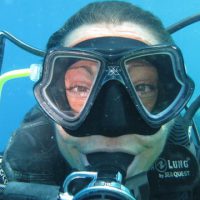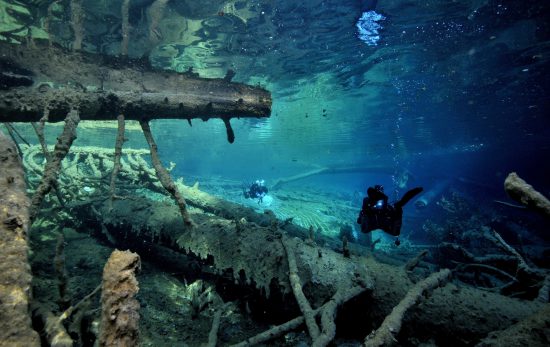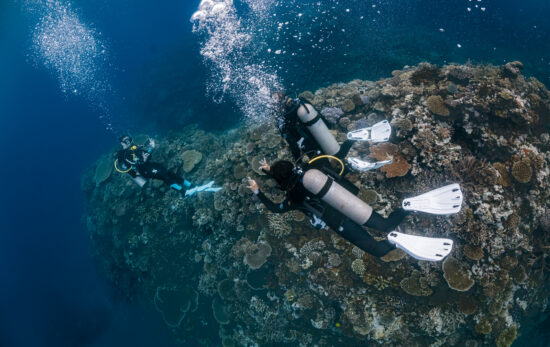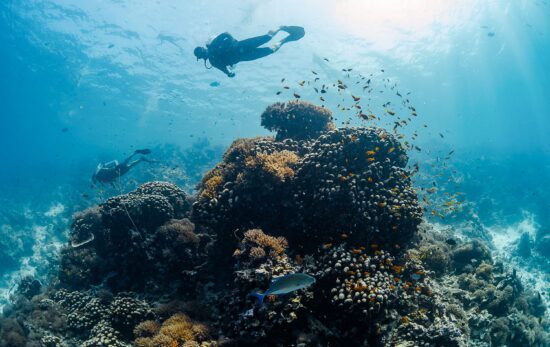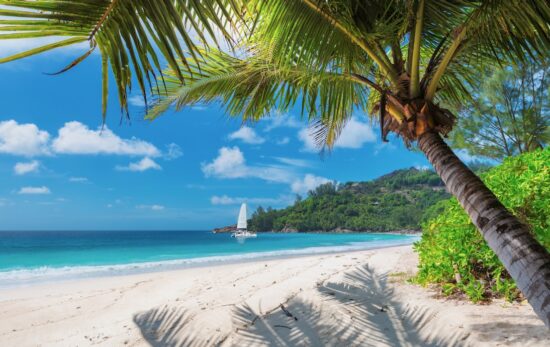New Zealand is a truly unique destination both on land and underwater. The staggering top-side scenery is mirrored equally, if not more, underwater. If you are wondering when to dive in New Zealand, in this article we take a look at 11 diving hotspots which offer a year round calendar of amazing dive sites to explore.

Kaikoura South Island (December to February)
If you are looking for once-in-a-lifetime diving, Kaikoura attracts dusky dolphins, albatross, New Zealand fur seals, and sperm whales. A dive into these waters might give you a magical experience of swimming with these majestic sea mammals.
You can dive year-round in Kaikoura, although summer offers the best water temperature and climate for exploring the coastline and mountains during non-diving days. The water temperature ranges from 50°F (10°C) in winter to 62°F (17°C) in summer, so a 7mm wetsuit or a drysuit is recommended.
Suggested PADI Courses: Drysuit Diver Specialty, Digital Underwater Photographer Specialty, Peak Performance Buoyancy Specialty
Milford Sound – Piopiotahi: Fiordland National Park (All Year)
The Fiordland National Park lies within the Te Wahipounamu World Heritage Area, and it is known for its calm water with excellent visibility.
Diving here is an exceptional experience. The sheer cliff faces of Milford Sound combined with the region’s heavy rainfall results in a unique ecosystem where black coral trees flourish. Milford Sound is also home to abundant macro life, including nudibranchs, a variety of crustaceans, several shark species, and a wide diversity of fish life. It’s possible to see some amazing marine mammals here, too, such as dolphins and New Zealand fur seals. Milford Sound is unique in that it’s the one place in New Zealand with coral diving available. Water temperature ranges from 54°F (12°C) in winter to 64°F (18°C) in late summer resulting in amazing diving all year round. A drysuit is recommended.
Suggested PADI Courses: Drysuit Diver Specialty, Underwater Naturalist Specialty, Peak Performance Buoyancy Specialty
Mercury and Aldermen Islands (January to March)
Located off the Coromandel Peninsula to the southeast of Mercury Bay, this region is home to the remnants of a volcanic complex. The rugged and rocky dive sites offer tunnels, pinnacles and a variety of pelagic marine species, including huge schools of mackerel which will leave any underwater photographer in awe. The Mercury Islands offer moray eels, crayfish, abundant nudibranchs and stunning above-water scenery of white, sandy bays and a rugged coastline.
This region is similar to Poor Knights and offers diving all year round, although the best time to dive is during the summer months when water temperatures are warmest. Temperatures range from approximately 57°F (14°C) in winter to 70°F (21°C) in late summer. At least a 5mm wetsuit with a hood is recommended in the summer, and a 7mm or more is necessary in the winter, depending on your personal cold tolerance levels.
Suggested PADI Courses: Digital Underwater Photographer Specialty, Underwater Naturalist Specialty, Fish Identification Specialty, Peak Performance Buoyancy Specialty

Kapiti Island and Wellington (January to June)
Kapiti Island is considered to offer the best scuba diving in Wellington. There is an enormous range of wildlife species on land, and underwater is just as varied.
The best time to dive is at the end of the summer from January through to June, and a 7mm wetsuit is recommended.
Suggested PADI Courses: Digital Underwater Photographer Specialty, Peak Performance Buoyancy Specialty, Underwater Naturalist Specialty
Tui Wreck & Caterbury Wreck (January to February)
The former research ship, HMNZS Tui, lies in 100 feet/30 meters of water and was strategically sunk to make an artificial reef. Penetration dives are possible when diving this 203-foot/62-meter-long wreck. There are purpose-cut access and exit points to explore the control room, bridge, crew living quarters and engine rooms. Outside of the wreck, another highlight is the golden snapper which school above the ship.
Slightly further north, the former Navy frigate Canterbury F421 now rests in Deep Water Cove near Cape Brett. Upright and intact, she makes for an impressive sight in a great dive location! Divers hit the bow at about 66 feet/20 meters and can swim through the bridge to the helicopter hanger at 86 feet/27 meters.
Water temperatures range from 65-77°F (19-25°C) during the summer months through to 57-62°F (14-17°C) during winter. A 7mm wetsuit with a hood can be used year round, depending on your personal tolerance levels. A drysuit during the winter may be more comfortable.
Suggested PADI Courses: Deep Diver Specialty, Wreck Diver Specialty, Advanced Open Water Diver
Rainbow Warrior (February to June)
Located in Matauri Bay in the Bay of Islands, the Rainbow Warrior was the flagship vessel for Greenpeace. She was sunk by the French foreign intelligence in 1985 while docked at the Auckland waterfront. The subsequent explosions resulted in the death of Fernando Pereira, a Portuguese-Dutch photographer. He had returned to the ship to gather his camera equipment after the first blast. After authorities refloated the ship for forensic examinations, it was relocated to Matauri Bay and scuttled as an artificial reef. It’s a popular wreck dive with an interesting history and vibrant marine life. The wreck offers divers colorful jewel anemones, John Dory, kingfish, moray eels and crayfish.
The warmest water and the best visibility can be enjoyed in the area from February to June. A 5mm wetsuit during the end of the summer and a 7mm wetsuit towards June is recommended.
Suggested PADI Courses: Wreck Diver Specialty, Peak Performance Buoyancy Specialty, Underwater Naturalist Specialty

Goat Island (February to June)
Goat Island is home to a myriad of marine life, including snapper, crayfish, and blue cod. You’ll also find a diversity of topographies, from rocky shores that are exposed during low tide to underwater cliffs, canyons, deep reefs, and sand flats, too. Each habitat boasts its own highlights, from seaweed forests, sea squirts, sponges and anemones through to shellfish. Goat Island also has abundant opportunities for underwater photography.
The warmest waters occur during the summer months when a 5mm wetsuit will be enough for most divers. For the cooler, winter months, a 7mm wetsuit and hood are recommended.
Suggested PADI Courses: Digital Underwater Photographer Specialty, Fish Identification Specialty, Underwater Naturalist Specialty
Poor Knights Islands (All Year)
Poor Knights Islands is renowned for being one of the best places to go scuba diving near Auckland, year-round! The Poor Knights Islands Marine Reserve is where an unusual blend of marine life thrives against a backdrop of sheer volcanic seamounts. The unique dive sites here straddle the line between the tropical and temperate South Pacific, and they boast a unique mix of marine life from both regions. Three stand-out dive sites include:
- Landing Bay Pinnacle: An impressive pinnacle dropping to 150 ft/46m. Look out for firebrick starfish, schooling mackerel and maomao.
- Rikoriko Cave: Known for its nocturnal nudibranchs and carpet sharks.
- Northern Arch: An iconic Poor Knights dive site featuring a huge undersea arch. Look out for short-tailed stingrays.
Suggested PADI Courses: Fish Identification Specialty, Underwater Naturalist Specialty, Deep Diver Specialty, Digital Underwater Photographer Specialty

Aramoana Mole, Dunedin (July to December)
Originally built to protect the pier, this man-made wall has become a popular dive site. Along with the wrecks of scuttled boats, New Zealand fur seals and kelp forests, there is plenty to keep divers entertained here dive after dive. Temperatures range from 50°F (10°C) in winter through to 65°F (18°C) in summer. Plus, this is one of the best dive sites to spot the rarest sea lion in the world – the Hooker Sea Lion.
Suggested PADI Courses: Underwater Naturalist Specialty, Peak Performance Buoyancy Specialty
Lermontov Wreck (October to April)
After striking rocks near Cape Jackson in 1986, the Mikhail Lermontov came to rest on the sea floor. This 20,000-ton Russian cruise liner is one of the world’s largest, dive-able wrecks, at 576 ft (176 m) long. A penetration dive on this wreck allows divers to access the ballroom while admiring the spiral staircases and chandeliers along the way.
The wreck is now also home to kelp, blue and red cod, blennies, dogfish, sea perch, carpet sharks, reef octopus, cuttlefish, and even an occasional kingfish.
The main diving season runs from October to April, with water temperatures ranging from 54°F (12°C) in winter to 68°F (20°C) in summer. A minimum 7mm wetsuit or drysuit is recommended, and for the warmest water, plan to dive between February and April.
Suggested PADI Courses: Wreck Diver Specialty, Drysuit Diver Specialty, Peak Performance Buoyancy Specialty
White Island (All Year)
Located off North Island and easily accessed from Whakatane, this diving destination is situated in the Bay of Plenty. White Island is home to an active volcano – evidence of which can be seen underwater by the bubbling vents in the seafloor.
There are three main dive sites here that are suitable for divers of all levels: Club Rocks, Volkner Rocks, and Liason’s Reef. Visibility around White Island is excellent, and the clear waters attract a myriad of tropical reef fish as well as passing pelagics. In places, you can see where lava has flowed into the water, and the topography is spectacular. There are a number of swim throughs and canyons that are well worth exploring for critters – or just for fun!
Suggested PADI Courses: Drysuit Diver Specialty, Peak Performance Buoyancy Specialty, Fish Identification Specialty, Digital Underwater Photographer Specialty

New Zealand Fact File
- New Zealand is made up of two main islands, North and South, as well as a number of smaller islands, including Stewart Island, Chatham Island, and the Great Barrier Island.
- New Zealand is approximately the same size as the United Kingdom but has only 6% of the UK’s population.
- It is thought that the first Māoris arrived in New Zealand between 1000 and 1200 AD, after traveling by canoes from Polynesia.
- When visiting New Zealand, your passport should have at least 3 months remaining validity.
- NZeTA allows citizens from the 60 countries in the Visa Waiver Programme to travel to New Zealand without the need to apply for a Visa Visitor and stay for a maximum of 3 months. For more information regarding visas for New Zealand, take a look at “New Zealand Visitor.Online“.
- If you are planning to travel around New Zealand, the public transport is excellent. The best option is air travel, but there are also extensive bus routes. For the ultimate in flexibility, many travelers hire camper vans and tour New Zealand independently.
- If you intend to fly around New Zealand internally, pay attention to the baggage allowances. When flying to some of the smaller airports using domestic airlines, you may need to pay excess baggage fees if you are traveling with your own gear.
- The currency of New Zealand is the New Zealand Dollar.
Are you feeling inspired to dive into New Zealand’s fascinating and exciting waters? Take a look at dive centers, resorts and livaboards in New Zealand on PADI Travel and start planning your next underwater adventure!
